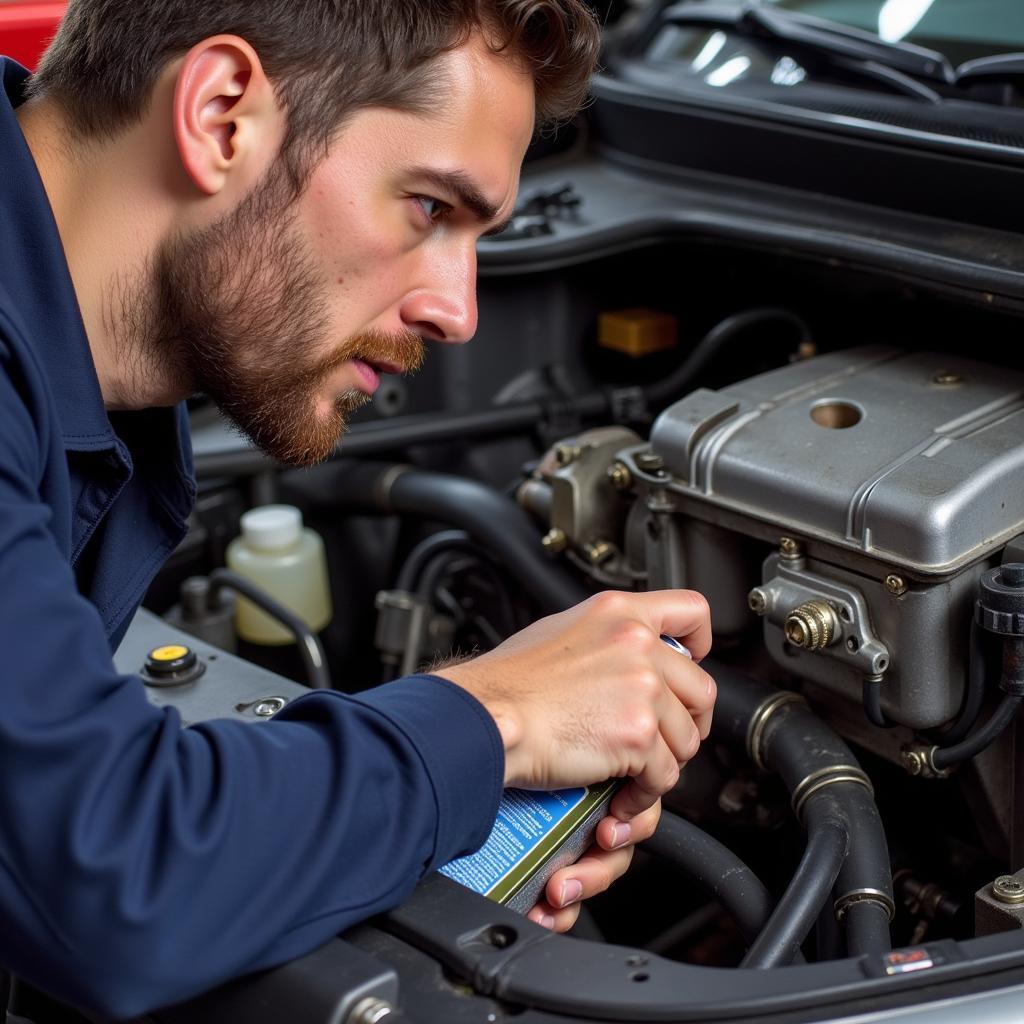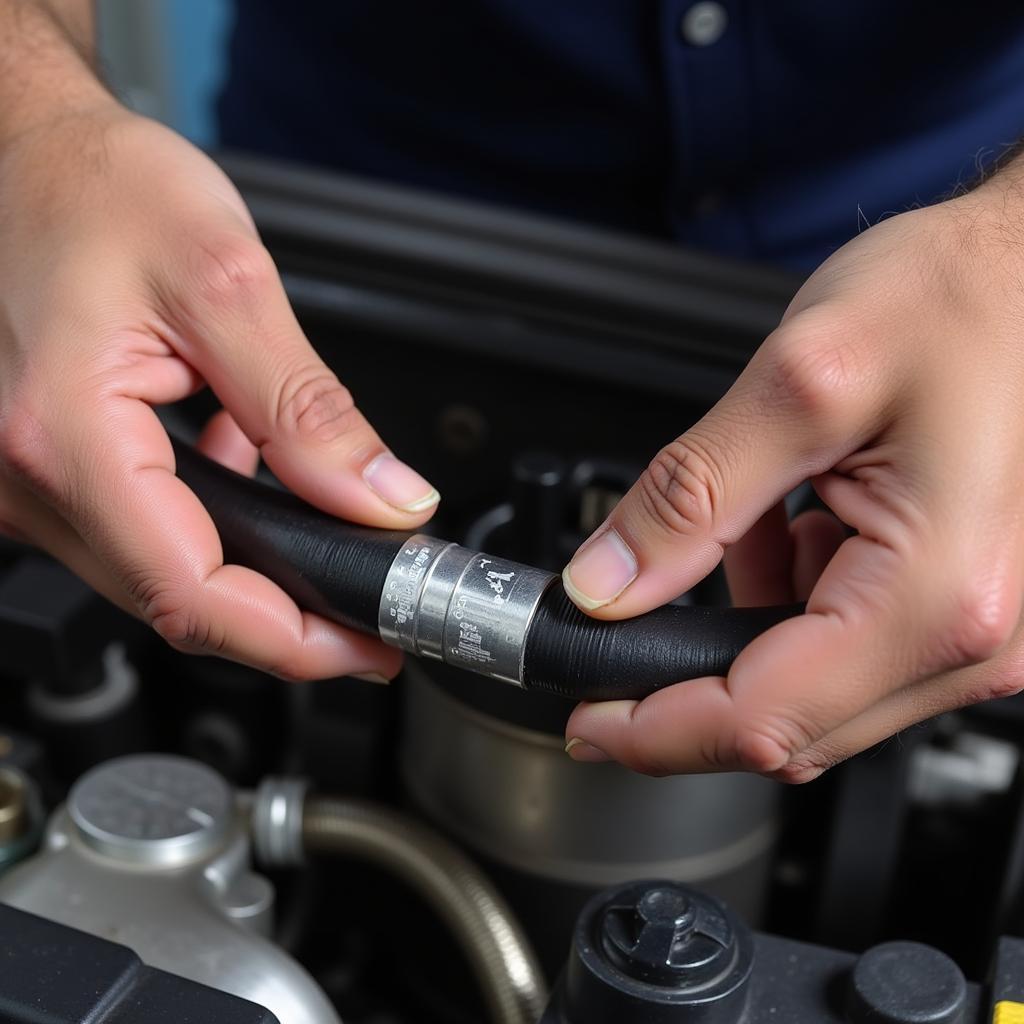High Idle Problems In A 5 Speed Car can be frustrating and concerning. A smooth, controlled idle is essential for fuel efficiency, comfortable driving, and overall engine health. If your 5-speed car is experiencing a high idle, this article will guide you through common causes, diagnostic steps, and potential solutions.
A high idle in a manual transmission vehicle can stem from various issues, ranging from a simple vacuum leak to a more complex sensor malfunction. Understanding these potential causes is the first step toward resolving the issue. Let’s explore some common culprits.
Understanding High Idle in 5 Speed Cars
High idle, where the engine RPM remains elevated at neutral, can be caused by a variety of factors. A key component in controlling idle speed is the Idle Air Control (IAC) valve. This valve regulates the amount of air bypassing the throttle plate, and a faulty IAC valve can lead to a persistently high idle.
A faulty IAC valve can cause various driveability issues, including rough idling, stalling, and increased fuel consumption. car ignition condenser problems can also contribute to a high idle, as a failing condenser may not suppress voltage spikes effectively, disrupting the ignition system.
Vacuum Leaks: A Common Culprit
Vacuum leaks are a frequent cause of high idle problems. A leak in the intake manifold or vacuum hoses disrupts the carefully balanced air-fuel mixture, causing the engine to rev higher than normal. Locating and repairing these leaks is crucial to restoring proper idle speed.
A simple way to check for vacuum leaks is to use a can of carburetor cleaner. With the engine running, spray the cleaner around potential leak points, such as vacuum hoses and the intake manifold gasket. A change in engine RPM indicates a leak.
 Vacuum Leak Detection in a 5-Speed Car
Vacuum Leak Detection in a 5-Speed Car
Throttle Cable and Linkage Issues
A sticky or improperly adjusted throttle cable or linkage can also contribute to a high idle. If the throttle plate doesn’t fully close, the engine will continue to receive more air than necessary, resulting in elevated RPMs.
Inspecting and adjusting the throttle cable and linkage is a relatively straightforward process. Ensure the cable moves freely and the throttle plate closes completely when the accelerator pedal is released.
Sensor Malfunctions: The Electronic Side of Things
Modern cars rely on various sensors to control engine functions, including idle speed. A malfunctioning sensor, such as the Throttle Position Sensor (TPS) or the Mass Air Flow (MAF) sensor, can send incorrect signals to the engine control unit (ECU), leading to a high idle.
Diagnosing sensor issues often requires specialized tools like a scan tool to read error codes and monitor sensor data. car problem rpms hign then drop can also manifest as a result of sensor problems, further emphasizing the importance of accurate diagnostics.
Diagnosing and Fixing High Idle Problems
Once you have identified the potential causes, the next step is to diagnose and fix the issue. A systematic approach is essential for efficient troubleshooting.
Checking for Vacuum Leaks
As mentioned earlier, vacuum leaks are a common culprit. Thoroughly inspect all vacuum hoses and connections for cracks, loose fittings, or damage. Replace any suspect hoses.
 Checking Vacuum Hoses for High Idle
Checking Vacuum Hoses for High Idle
Inspecting the Throttle Cable and Linkage
Check the throttle cable for smooth operation and ensure the throttle plate closes completely when the accelerator pedal is released. Adjust or replace the cable or linkage if necessary.
Testing Sensors with a Scan Tool
A scan tool is essential for diagnosing sensor problems. Connect the tool to the car’s diagnostic port and read any stored error codes. The codes will provide clues about which sensor might be malfunctioning.
Expert Insight: “A scan tool is an invaluable tool for diagnosing modern car problems. It allows you to see what the car’s computer is seeing, providing valuable insights into sensor readings and potential faults,” says John Smith, Automotive Engineer at Smith Automotive Solutions.
classic car coil problems can also manifest as high idle, particularly in older vehicles. A weak or failing coil can disrupt the ignition timing, leading to erratic engine behavior.
Preventing Future High Idle Issues
Regular maintenance is crucial for preventing future high idle problems. Keep your engine clean, check vacuum hoses regularly, and ensure the throttle cable and linkage are properly adjusted.
Expert Insight: “Preventive maintenance is always better than reactive repairs. Regularly checking your car’s essential components can prevent many issues, saving you time and money in the long run,” says Jane Doe, Certified Mechanic at Doe’s Auto Repair.
velocity problems a gold car and green car although seemingly unrelated, can sometimes point towards underlying issues that may also affect idling. It’s crucial to maintain a holistic view of your vehicle’s performance.
Conclusion
High idle problems in a 5 speed car can be traced back to several root causes, including vacuum leaks, throttle cable issues, and sensor malfunctions. By systematically diagnosing and addressing these issues, you can restore proper idle speed and ensure optimal engine performance. Remember, regular maintenance is key to preventing future problems. If you’re still experiencing issues, connect with AutoTipPro at +1 (641) 206-8880 or visit our office at 500 N St Mary’s St, San Antonio, TX 78205, United States.
high rpm car problem can share similarities with high idle issues, highlighting the importance of a comprehensive diagnostic approach.
FAQ:
-
What is a normal idle speed for a 5-speed car? A normal idle speed typically ranges between 600-1000 RPM.
-
Can a dirty air filter cause high idle? While not a direct cause, a very dirty air filter can contribute to running issues which may affect idle speed.
-
How can I check my IAC valve? Testing the IAC valve often requires specialized equipment and is best left to a qualified mechanic.
-
What tools do I need to diagnose high idle problems? Basic tools like a screwdriver and pliers can be helpful, but a scan tool is often necessary for diagnosing sensor issues.
-
Is it safe to drive with a high idle? Driving with a persistent high idle can increase fuel consumption and potentially damage the engine over time.
-
Can a faulty oxygen sensor cause high idle? Yes, a malfunctioning oxygen sensor can disrupt the air-fuel mixture, potentially leading to a high idle.
-
My car idles high when cold but normalizes when warm. Is this normal? Some variation in idle speed when cold is normal, but a significantly high idle, even when cold, warrants investigation.




Leave a Reply